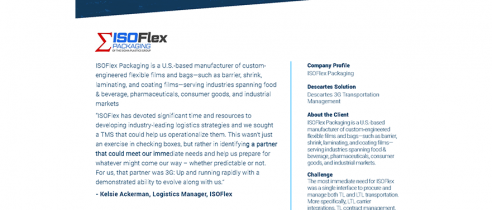Carrier rates — the price for transporting goods from one location to another — are among the most critical variables in the logistics and shipping industry. They influence shipment/dimensional weight, mode of transport, route allocations, container capacity, and more, indirectly dictating budgets across the sector.
With that in mind, the recent carrier rate surges have caused relative pandemonium, squeezing profit margins among shipping companies worldwide.
Understanding Carrier Rate Increases
The GRI, or General Rate Increase or annual percentage increase, represents the adjustment in shipping rates that carriers typically implement every year. It accounts for changes in the supply chain, raw materials, and more. It is usually scheduled in advance to mitigate the effects of market fluctuations, rising operational costs, or other industry challenges.
Today, the most prominent events encouraging the recent rate hikes include:
- the Red Sea crisis;
- the market demand versus the lack of capacity; and
- the sky-rocketing fuel costs.
How Global Economic Conditions Impact Carrier Rates
Aside from modern urgencies, long-standing global economic variables have a decisive effect on carrier rates. Currency exchange rates, inflation (rate of price increases over a specified period), and economic trends can direct transportation costs, thus carrier rates.
3 Primary Factors Driving Carrier Rate Increases
#1 Fuel Costs
Statista data shows the global fuel price reached 202.89 in October 2023, marking a considerable increase from 2016 (base year) when it settled at 100. While the same chart shows a noticeable drop in January 2024, the current 173.66 level remains markedly higher than the base.
The stubbornly high fuel costs add an extra burden to the operational expenses of trucking companies and shipping carriers, prompting the recent rate surges. Unsurprisingly, fuel constitutes a significant portion of their budgets, affecting everything from warehousing to transportation.
#2 Supply Chain Disruptions
The COVID-19 pandemic disrupted the global supply chain and businesses like nothing else, with an Ernst & Young LLP survey noting that only 2% of businesses were ready for such unprecedented times. And while many companies have somewhat recovered from the devastating impacts, the current Red Sea shipping crisis presents new supply chain disruptions, wreaking havoc on carrier rates.
According to J.P. Morgan data, 30% of global container trade heads through the Suez Canal. As such, present disruptions are upending worldwide supply chains. These huge setbacks drive the prices of routes still in operation, with some (primarily from Asia to Europe) increasing almost five-fold.
#3 Market Demand VS Capacity Constraints
Changing regulations, failure to operate at total capacity, lack of drivers, and extreme weather drive capacity constraints across the industry. Such problems have far-reaching impacts, but the most keenly felt are carrier rate increases.
As market demand surges, the logistics sector needs more time and resources to adapt, causing capacity impediments at ports and last-mile distribution centers across the United States. Plus, the need for more drivers and other integral sector workers is abolishing companies’ abilities to provide cost-effective, efficient shipping services.
Implications for Shipping Companies
Naturally, the carrier rate increases instantly impact shipping companies, who are forced into raising their budgets and tightening profit margins. But these hikes have brought more than surface-level financial woes — they’ve changed businesses’ abilities to balance service quality with prices.
Market demand is higher than ever, but so are consumer expectations. Shippers are toiling to devise a plan that meets the speed and cheapness people expect from shipping providers.
Impact on Consumers and Businesses
Shipping companies aren’t the only entities affected by carrier rate surges. Both businesses and consumers are adversely impacted by general rate increases, with the increases trickling down to product pricing, reflecting spending patterns.
Product Pricing
Freight costs are a primary driver of global inflation — when carrier rates double, inflation booms by approximately 0.7%. These effects are remarkably persistent, reaching their peak after 12 months and lasting for 18 months.
While this pass-through to inflation is less massive than those associated with food or fuel costs, freight rates are decidedly more volatile. Thus, the variation contribution is similar to global food/oil price shocks.
The effect on consumer wallets is slower than the profit-squeezing impacts for businesses. However, it eventually trickles down and raises the prices of goods across all industries.
Consumer Spending Patterns
As carrier rate increases raise goods’ costs, consumer spending behaviors shift, creating a ripple effect across retail and other B2C industries. The hiked prices steal spending power from consumers, causing them to become less open to spending money, particularly on discretionary goods.
Business Challenges and Opportunities
The booming carrier costs are considerably tightening profit margins for parcel carriers, forcing businesses to raise their shipping prices for consumers, which only encourages said consumers to shop elsewhere.
However, companies can find opportunities amongst the challenges, such as:
- changing inventory location,
- reducing package weight/dimensions,
- looking for cheaper rates,
- using flat-rate shipping and
- swapping to more sustainable practices.
The Industry’s Response to Carrier Rate Increases
The industry is wrangling with both collaboration and negotiation in response to the rate increases, with many participants doing the following:
- attempting to develop stronger relationships with current shipping partners;
- taking advantage of dedicated capacity;
- looking for ways to reduce weight and volume;
- requesting volume discounts;
- negotiating longer contract terms, and
- using online freight marketplaces.
Future Trends and Projections
As the calendar continues flicking through 2024, LTL rates nationwide are expected to rise 4.1% on average. This follows a 2.4% increase last year, according to Avery Vise, vice president of trucking. While this is a penny-pinching hike, the trajectory is more manageable than the industry feared after Yellow collapsed.
The global containership fleet is set to grow by 6.8% this year, reaching a record high of 2.7 million TEUs. Drewery forecasts predict this overcapacity will depress container freight rates by 33.6%.
Mounting uncertainty surrounding the Suez Canal and the crisis-induced reroutes could impact food costs, greenhouse gas emissions, and foreign trade partnerships worldwide.







